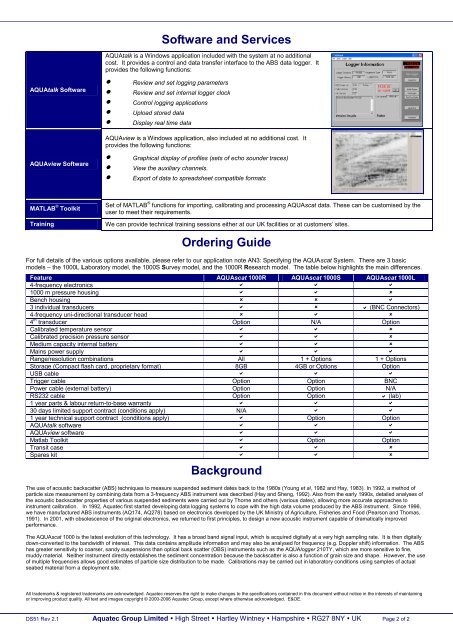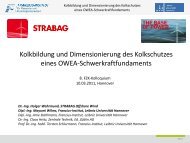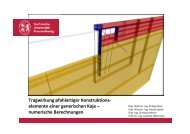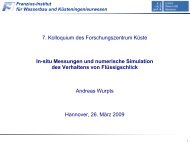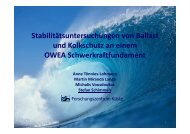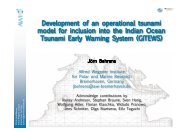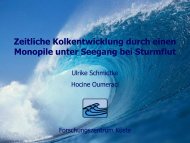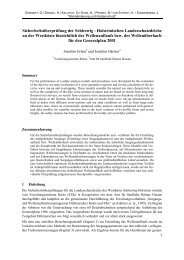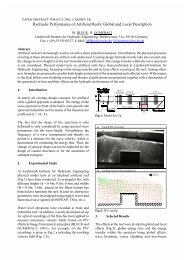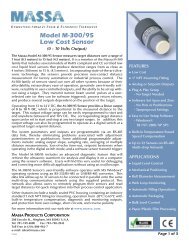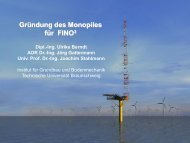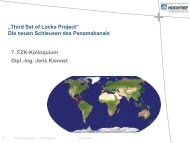The AQUAscat 1000 Acoustic Backscatter System - FZK
The AQUAscat 1000 Acoustic Backscatter System - FZK
The AQUAscat 1000 Acoustic Backscatter System - FZK
Create successful ePaper yourself
Turn your PDF publications into a flip-book with our unique Google optimized e-Paper software.
AQUAtalk Software<br />
AQUAview Software<br />
MATLAB ® Toolkit<br />
Software and Services<br />
AQUAtalk is a Windows application included with the system at no additional<br />
cost. It provides a control and data transfer interface to the ABS data logger. It<br />
provides the following functions:<br />
Review and set logging parameters<br />
Review and set internal logger clock<br />
Control logging applications<br />
Upload stored data<br />
Display real time data<br />
AQUAview is a Windows application, also included at no additional cost. It<br />
provides the following functions:<br />
Graphical display of profiles (sets of echo sounder traces)<br />
View the auxiliary channels.<br />
Export of data to spreadsheet compatible formats<br />
Set of MATLAB ® functions for importing, calibrating and processing <strong>AQUAscat</strong> data. <strong>The</strong>se can be customised by the<br />
user to meet their requirements.<br />
Training We can provide technical training sessions either at our UK facilities or at customers’ sites.<br />
Ordering Guide<br />
For full details of the various options available, please refer to our application note AN3: Specifying the <strong>AQUAscat</strong> <strong>System</strong>. <strong>The</strong>re are 3 basic<br />
models –the <strong>1000</strong>L Laboratory model, the <strong>1000</strong>S Survey model, and the <strong>1000</strong>R Research model. <strong>The</strong> table below highlights the main differences.<br />
Feature <strong>AQUAscat</strong> <strong>1000</strong>R <strong>AQUAscat</strong> <strong>1000</strong>S <strong>AQUAscat</strong> <strong>1000</strong>L<br />
4-frequency electronics <br />
<strong>1000</strong> m pressure housing <br />
Bench housing <br />
3 individual transducers (BNC Connectors)<br />
4-frequency uni-directional transducer head <br />
4 th transducer Option N/A Option<br />
Calibrated temperature sensor <br />
Calibrated precision pressure sensor <br />
Medium capacity internal battery <br />
Mains power supply <br />
Range/resolution combinations All 1 + Options 1 + Options<br />
Storage (Compact flash card, proprietary format) 8GB 4GB or Options Option<br />
USB cable <br />
Trigger cable Option Option BNC<br />
Power cable (external battery) Option Option N/A<br />
RS232 cable Option Option (lab)<br />
1 year parts & labour return-to-base warranty <br />
30 days limited support contract (conditions apply) N/A <br />
1 year technical support contract (conditions apply) Option Option<br />
AQUAtalk software <br />
AQUAview software <br />
Matlab Toolkit Option Option<br />
Transit case <br />
Spares kit <br />
Background<br />
<strong>The</strong> use of acoustic backscatter (ABS) techniques to measure suspended sediment dates back to the 1980s (Young et al, 1982 and Hay, 1983). In 1992, a method of<br />
particle size measurement by combining data from a 3-frequency ABS instrument was described (Hay and Sheng, 1992). Also from the early 1990s, detailed analyses of<br />
the acoustic backscatter properties of various suspended sediments were carried out by Thorne and others (various dates), allowing more accurate approaches to<br />
instrument calibration. In 1992, Aquatec first started developing data logging systems to cope with the high data volume produced by the ABS instrument. Since 1996,<br />
we have manufactured ABS instruments (AQ174, AQ278) based on electronics developed by the UK Ministry of Agriculture, Fisheries and Food (Pearson and Thomas,<br />
1991). In 2001, with obsolescence of the original electronics, we returned to first principles, to design a new acoustic instrument capable of dramatically improved<br />
performance.<br />
<strong>The</strong> <strong>AQUAscat</strong> <strong>1000</strong> is the latest evolution of this technology. It has a broad band signal input, which is acquired digitally at a very high sampling rate. It is then digitally<br />
down-converted to the bandwidth of interest. This data contains amplitude information and may also be analysed for frequency (e.g. Doppler shift) information. <strong>The</strong> ABS<br />
has greater sensitivity to coarser, sandy suspensions than optical back scatter (OBS) instruments such as the AQUAlogger 210TY, which are more sensitive to fine,<br />
muddy material. Neither instrument directly establishes the sediment concentration because the backscatter is also a function of grain size and shape. However, the use<br />
of multiple frequencies allows good estimates of particle size distribution to be made. Calibrations may be carried out in laboratory conditions using samples of actual<br />
seabed material from a deployment site.<br />
All trademarks & registered trademarks are acknowledged. Aquatec reserves the right to make changes to the specifications contained in this document without notice in the interests of maintaining<br />
or improving product quality. All text and images copyright © 2000-2006 Aquatec Group, except where otherwise acknowledged. E&OE.<br />
DS51 Rev 2.1 Aquatec Group Limited High Street Hartley Wintney Hampshire RG27 8NY UK Page 2 of 2


